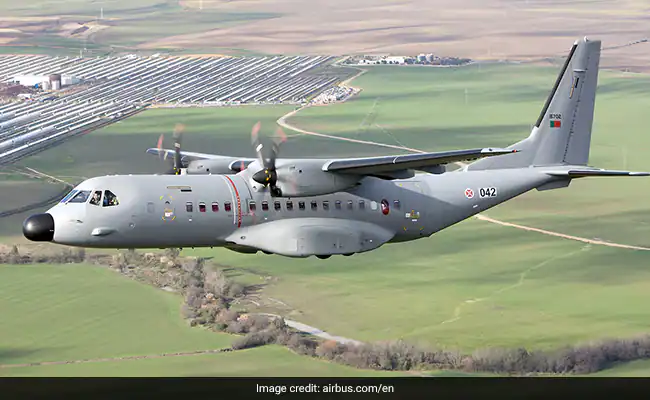Governance
C-295 Aircraft
- 03 Nov 2022
- 7 min read
For Mains: C-295 Aircraft and Significance of its Manufacturing Project.
Why in News?
Recently, Prime Minister of India has laid the foundation stone for the C-295 transport aircraft manufacturing facility in Vadodara to be set up by Airbus Defence and Space S.A., Spain and Tata Advanced Systems Limited (TASL).
- This is the first time a private sector company would be manufacturing a full aircraft in the country.
What is the C-295 MW transporter?
- About:
- The C-295 is a transport aircraft of 5-10 tonne capacity with contemporary technology.
- Robust and reliable, it is a versatile and efficient tactical transport aircraft which can perform a number of different missions.
- Features:
- The aircraft, with a flight endurance of up to 11 hours, can carry out multi-role operations under all weather conditions.
- It can routinely operate day as well as night combat missions from desert to maritime environments.
- It has a rear ramp door for quick reaction and para dropping of troops and cargo. Short take-off/land from semi-prepared surfaces is another of its features.
- Replacement:
- It will replace the Indian Air Force’s ageing fleet of Avro-748 planes.
- The Avro-748 planes are a British-origin twin-engine turboprop, military transport and freighter with a 6-tonne freight capacity.
- It will replace the Indian Air Force’s ageing fleet of Avro-748 planes.
- Project Execution:
- TASL will jointly execute the project to equip the air force with the new transport aircraft under the Make-in-India initiative in the aerospace sector.
- Airbus will supply the first 16 aircraft in fly away condition between September 2023 and August 2025 while the remaining 40 will be assembled in India by TASL between September 2026 and 2031 at the rate of eight aircraft per year.
- TASL will jointly execute the project to equip the air force with the new transport aircraft under the Make-in-India initiative in the aerospace sector.
What is the Significance of this Manufacturing Facility?
- Employment Generation:
- The TATA Consortium has identified more than 125 in-country MSME suppliers spread over seven states. This will act as a catalyst in employment generation in the aerospace ecosystem of the country.
- It is expected to generate 600 highly skilled jobs directly, over 3000 indirect jobs, and an additional 3000 medium-skill employment opportunities with more than 42.5 lakh man hours of work within the aerospace and defence sector of India.
- Boost MSMEs:
- The project will give a boost to the aerospace ecosystem in India wherein several Micro, Small and Medium Enterprises (MSMEs) spread over the country will be involved in manufacturing of parts of the aircraft.
- Reduce Import Dependence:
- The project will augment domestic aviation manufacturing resulting in reduced import dependence and expected increase in exports.
- A large number of detail parts, sub-assemblies and major component assemblies of aero structure are scheduled to be manufactured in India.
- Infrastructure Development:
- It will involve development of specialized infrastructure in the form of hangars, buildings, aprons and taxiways.
- Before completion of deliveries, ‘D’ Level servicing facility (MRO) for C-295MW aircraft are scheduled to be set up in India.
- It is expected that this facility will act as a regional MRO (Maintenance, Repair and Overhaul) hub for various variants of C-295 aircraft.
- Offset Obligations:
- Airbus will discharge its offset obligations through direct purchase of eligible products and services from Indian offset partners giving further boost to the economy.
- In simplest terms, the offset is an obligation by an international player to boost India’s domestic defence industry if India is buying defence equipment from it.
What is the Potential of India’s Civil Aviation Sector?
- India has a much bigger footprint in civil aviation manufacturing than defence, in addition to being a major market itself. Both Airbus and Boeing, the USA, do significant sourcing from India for their civil programmes.
- Boeing’s sourcing from India stands at USD 1 billion annually, of which over 60% is in manufacturing
- India buys manufactured parts and engineering services worth USD 650 million every year from more than 45 Indian suppliers.
- India, which is moving ahead with the mantra of ‘Make in India’ and ‘Make for the Globe’, continues to enhance its potential by becoming a major manufacturer of transport planes.
- Since 2007, Airbus has had a wholly domestic-owned design centre in India which has more than 650 engineers who specialise in high-tech aeronautical engineering and work across both fixed- and rotary-wing Airbus aircraft programmes.
- It is estimated that in the coming 10-15 years, India will need about 2000 more passenger and cargo aircraft.
- Another major growing area is MRO for which India can emerge as the regional hub.
- MRO is any action that helps keep or restore an item to its working condition.
UPSC Civil Services Examination Previous Year Question:
Q. International civil aviation laws provide all countries complete and exclusive sovereignty over the airspace above their territory. What do you understand by ‘airspace’? What are the implications of these laws on the space above this airspace? Discuss the challenges which this poses and suggest ways to contain the threat. (2014)
Q. Examine the development of Airports in India through joint ventures under Public–Private Partnership (PPP) model. What are the challenges faced by the authorities in this regard? (2017)





